Point modification parameters
Selection
Offers icons corresponding to different selection options.
Action
Offers icons to cut or modify the points.
|
|
cuts points. |
|
|
validates the modification. |
To represent circles
x,y,z
Enter the new coordinates of the selected point.
Distance
- Pull the arrow to draw the selected point to its new position.
- Use the contextual menu of Distance to select the translation direction of the selected point:
- Along X axis,
- Along Y axis,
- Along Z axis,
- Along tool axis,
- Along last polyline, i.e. along a line created between the previous point and the point selected,
- Along next polyline, i.e. along a line created between the next point and the point selected.
- Or double-click the word Distance and enter the distance in the box.
Area modification parameters
Selection Mode
- Before/In selected geometry: The area of tool path selected is before
the point selected,
or between the two points selected. - After/Out selected geometry: The area of tool path selected is after
the point selected,
or outside the two points selected.
Copy transformation
Check this option to copy a cut area of the tool path in the specification tree.
Distance
- Pull the arrow to draw the selected area of the tool path to its new position.
- Use the contextual menu of Distance to select the translation direction of the selected area of the tool path:
- Along X axis,
- Along Y axis,
- Along Z axis,
- Along tool axis.
- Or double-click the word Distance and enter the distance in the box.
Translation parameters
Distance
- Pull the arrow to draw the selected area of the tool path to its new position.
- Use the contextual menu of Distance to select the translation direction of the selected area of the tool path:
- Along X axis,
- Along Y axis,
- Along Z axis,
- Along tool axis.
- Or double-click the word Distance and enter the distance in the box.
Rotation parameters
Angle
- Pull the arrow to draw the selected area of the tool path to its new position.
- Use the contextual menu of Angle to select the rotation axis of the selected area of the tool path:
- Rotation around X axis,
- Rotation around Y axis,
- Rotation around Z axis,
- Rotation around tool axis.
- Or double-click the word Angle and enter the angle in the box
Connect parameters
Selection
Offers icons corresponding to different selection options.
Connection mode
|
|
Connects points directly |
|
|
Connects points through a plane |
|
|
Connects points through the safety plane of the operation. |
Distance
Defines the distance the tool will rise to.
X, Y, Z and Nx, Ny, Nz
Define the safety plane through a point and a normal. The connection will go through the point in the plane.
Change approach and retract parameters
Delete
Filter
Check the type of the path you want to delete:
- Approach
- Retract
- Linking passes
- Between paths
You can select several types.
Remove from whole tool path
The action takes the whole tool path into account.
Remove from area inside polygon
The action takes only the selected portion of the tool path into account.
You select this portion by drawing a polygon on the tool path.
Add/Modify
Selection
Offers icons corresponding to different selection options.
Apply
Lets you define the domain of application: either the whole tool path or a portion selected with Selection.
Approach/Retract
The tool moves along the tool axis for a given Length.
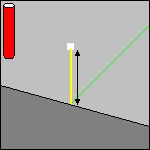
No approach/retract.
BackThe tool doubles back like an arrow above the cutting tool path.
You can either define this type with Cartesian coordinates (Distance
and Height) or
Polar coordinates (Angle and Radius).
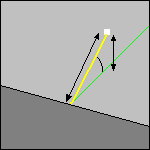
The tool moves towards/away from the part in an arc.
You can choose to compute the plane in which the tool moves either
Automatically or
Manually.
The parameters that you can set are:
- the Length,
- the Angle
- the Radius
- the Normal vector to plane.
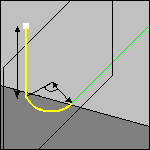
The tool moves across the diagonal of an imaginary box, either in a
straight line or in a curve (Linking
mode).
The Length is the distance that the tool will move in once it has
crossed the box.
The box is defined by three distance values:
- the distance along the tangent,
- the distance along the tool axis (can be a negative value) ,
- the distance along the normal axis,
- The direction of the box diagonal is defined by whether you want to
use the normal to the left or
the right of the end of the tool path. Left or right of the Side of normal axis is determined by looking
along the tool path in the direction of the approach/retract.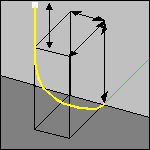
Check Tool Length and Split on Collision Points parameters
Extra geometry
Allows you to add additional geometry to the part in the operation where
the tool path was computed.
Additional geometry may be a face or a clamp that you would rather avoid
using in the computation and
that is not defined in the
operation
Use part
Check this option to use the part you defined in the operation to compute the collision points.
Collision tolerance
Discretization distance to check for collision between the tool and the part.
Offset on tool holder radius (dR)
Safety distance for the tool holder radius to avoid collision between the holder and the part.
Offset on tool length (dL)
Safety distance for the tool holder length to avoid collision between the holder and the part.
Create Geometries parameterss
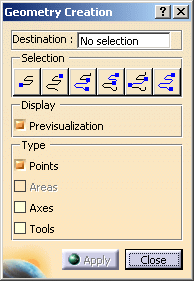
Destination
Defines the partbody of the geometrical set where the geometry will be created.
Selection
|
|
Selects the first point of the tool path. |
|
|
Selects the last point of the tool path. |
|
|
Selects all the points between the first point of the tool path and the point picked. |
|
|
Selects all the points between the point picked and the last point of the tool path. |
|
|
Selects all the points between two points picked. |
|
|
Selects all the points of the tool path. |
You can also pick one point on the tool path.
Display
By default, the Previsualization option is activated, i.e. the
element of the type selected below is visualized.
You can deselect this option. However, the points of the tool path are
always visualized.
|
|
If you want to only visualize the geometry, do not push the
Apply button since it would create he elements of the type selected. |
Type
Select the type of elements you want to visualize or to create.
- Points: Creates points.
- Areas: Available if the type Points is selected,
and if several points of the tool path are selected.
Creates a join of lines from the portions of path selected. - Axes: Creates tool axes (as points and lines).
- Tools: Creates tools (as revolves).
Apply
Apply becomes available once you have selected a
Destination.
It creates the elements of the type you have selected.
Select an area and a type of elements to create, push Apply, then repeat
these steps
to create elements on several areas.
Close
Exit the action. The elements created by Apply are not erased.